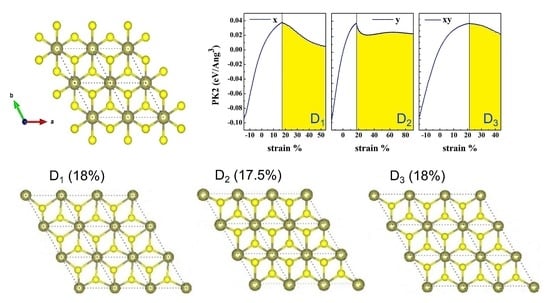A First-Principles Study of Nonlinear Elastic Behavior and Anisotropic Electronic Properties of Two-Dimensional HfS2
Abstract
1. Introduction
2. Computational Details
3. Results and Discussion
3.1. Atomic Structure
3.2. Mechanical Properties
3.3. Strain-Stress Relationship
3.4. Electronic Properties
4. Conclusions
Author Contributions
Funding
Conflicts of Interest
References
- Kang, J.; Tongay, S.; Zhou, J.; Li, J.; Wu, J. Band offsets and heterostructures of two-dimensional semiconductors. Appl. Phys. Lett. 2013, 102, 012111. [Google Scholar] [CrossRef]
- Neto, A.; Novoselov, K. Two-dimensional crystals: Beyond graphene. Mater. Express 2011, 1, 10–17. [Google Scholar] [CrossRef]
- Gui, G.; Li, J.; Zhong, J. Band structure engineering of graphene by strain: First-principles calculations. Phys. Rev. B 2008, 78, 075435. [Google Scholar] [CrossRef]
- Chhowalla, M.; Shin, H.S.; Eda, G.; Li, L.-J.; Loh, K.P.; Zhang, H. The chemistry of two-dimensional layered transition metal dichalcogenide nanosheets. Nat. Chem. 2013, 5, 263. [Google Scholar] [CrossRef]
- Ansari, R.; Malakpour, S.; Faghihnasiri, M.; Ajori, S. Structural and elastic properties of carbon nanotubes containing Fe atoms using first principles. Superlattices Microstruct. 2013, 64, 220–226. [Google Scholar] [CrossRef]
- Butler, S.Z.; Hollen, S.M.; Cao, L.; Cui, Y.; Gupta, J.A.; Gutiérrez, H.R.; Heinz, T.F.; Hong, S.S.; Huang, J.; Ismach, A.F.; et al. Progress, challenges, and opportunities in two-dimensional materials beyond graphene. ACS Nano 2013, 7, 2898–2926. [Google Scholar] [CrossRef]
- Xu, K.; Wang, Z.; Wang, F.; Huang, Y.; Wang, F.; Yin, L.; Jiang, C.; He, J. Ultrasensitive Phototransistors Based on Few-Layered HfS2. Adv. Mater. 2015, 27, 7881–7887. [Google Scholar] [CrossRef]
- Ahmadi, A.; Faghihnasiri, M.; Shiraz, H.G.; Sabeti, M. Mechanical properties of graphene and its analogous decorated with Na and Pt. Superlattice Microstruct. 2017, 101, 602–608. [Google Scholar] [CrossRef]
- Faghihnasiri, M.; Jafari, H.; Ramazani, A.; Shabani, M.; Estalaki, S.M.; Larson, R.G. Nonlinear elastic behavior and anisotropic electronic properties of two-dimensional borophene. J. Appl. Phys. 2019, 125, 145107. [Google Scholar] [CrossRef]
- Wang, Q.H.; Kalantar-Zadeh, K.; Kis, A.; Coleman, J.N.; Strano, M.S. Electronics and optoelectronics of two-dimensional transition metal dichalcogenides. Nat. Nanotechnol. 2012, 7, 699. [Google Scholar] [CrossRef]
- Abderrahmane, A.; Ko, P.; Thu, T.; Ishizawa, S.; Takamura, T.; Sandhu, A. High photosensitivity few-layered MoSe2 back-gated field-effect phototransistors. Nanotechnology 2014, 25, 365202. [Google Scholar] [CrossRef] [PubMed]
- Liu, W.; Kang, J.; Sarkar, D.; Khatami, Y.; Jena, D.; Banerjee, K. Role of metal contacts in designing high-performance monolayer n-type WSe2 field effect transistors. Nano Lett. 2013, 13, 1983–1990. [Google Scholar] [CrossRef] [PubMed]
- Gomez, L.; Aberg, I.; Hoyt, J. Electron transport in strained-silicon directly on insulator ultrathin-body n-MOSFETs with body thickness ranging from 2 to 25 nm. IEEE Electron Device Lett. 2007, 28, 285–287. [Google Scholar] [CrossRef]
- Derived, C. Ultrasmooth Graphene Nanoribbon Semiconductors. Science 2008, 319, 1229–1232. [Google Scholar]
- Zhang, W.; Huang, Z.; Zhang, W.; Li, Y. Two-dimensional semiconductors with possible high room temperature mobility. Nano Res. 2014, 7, 1731–1737. [Google Scholar] [CrossRef]
- Zhao, X.; Wang, T.; Wang, G.; Dai, X.; Xia, C.; Yang, L. Electronic and magnetic properties of 1T-HfS2 by doping transition-metal atoms. Appl. Surf. Sci. 2016, 383, 151–158. [Google Scholar] [CrossRef]
- Ahmadi, A.; Jafari, H.; Rajipour, M.; Fattahi, R.; Faghihnasiri, M. Nonlinear electronic transport behavior of γ-graphyne nanotubes. IEEE Trans. Electron Devices 2019, 66, 1584–1590. [Google Scholar] [CrossRef]
- Novoselov, K.S.; Jiang, D.; Schedin, F.; Booth, T.J.; Khotkevich, V.V.; Morozov, S.V.; Geim, A.K. Two-dimensional atomic crystals. Proc. Natl. Acad. Sci. USA 2005, 102, 10451–10453. [Google Scholar] [CrossRef]
- Novoselov, K.S.; Geim, A.K.; Morozov, S.V.; Jiang, D.; Zhang, Y.; Dubonos, S.V.; Grigorieva, I.V.; Firsov, A.A. Electric field effect in atomically thin carbon films. Science 2004, 306, 666–669. [Google Scholar] [CrossRef]
- Krowne, C.M. Introduction to examination of 2D hexagonal band structure from a nanoscale perspective for use in electronic transport devices. Adv. Imag. Elect. Phys. 2019, 210, 1. [Google Scholar]
- Krowne, C.M. Graphyne and Borophene as Nanoscopic Materials for Electronics. arXiv 2019, arXiv:1912.10876. [Google Scholar]
- Schwierz, F. Graphene transistors. Nat. Nanotechnol. 2010, 5, 487. [Google Scholar] [CrossRef] [PubMed]
- Hu, P.; Wen, Z.; Wang, L.; Tan, P.; Xiao, K. Synthesis of few-layer GaSe nanosheets for high performance photodetectors. ACS Nano 2012, 6, 5988–5994. [Google Scholar] [CrossRef] [PubMed]
- Radisavljevic, B.; Radenovic, A.; Brivio, J.; Giacometti, I.V.; Kis, A. Single-layer MoS2 transistors. Nat. Nanotechnol. 2011, 6, 147. [Google Scholar] [CrossRef] [PubMed]
- Chen, H.; Müller, M.B.; Gilmore, K.J.; Wallace, G.G.; Li, D. Mechanically strong, electrically conductive, and biocompatible graphene paper. Adv. Mater. 2008, 20, 3557–3561. [Google Scholar] [CrossRef]
- Chen, J. Phonons in bulk and monolayer HfS2 and possibility of phonon-mediated superconductivity: A first-principles study. Solid State Commun. 2016, 237, 14–18. [Google Scholar] [CrossRef]
- Kang, J.; Sahin, H.; Peeters, F.M. Mechanical properties of monolayer sulphides: A comparative study between MoS2, HfS2 and TiS3. Phys. Chem. Chem. Phys. 2015, 17, 27742–27749. [Google Scholar] [CrossRef]
- Blöchl, P.E. Projector augmented-wave method. Phys. Rev. B 1994, 50, 17953. [Google Scholar] [CrossRef]
- Espresso, Q. A modular and open-source software project for quantum simulations of materials/P. J. Phys. Condens. Matter 2009, 21, 395502. [Google Scholar]
- Perdew, J.P.; Ruzsinszky, A.; Csonka, G.; Vydrov, O.A.; Scuseria, G.E.; Constantin, L.A.; Zhou, X.; Burke, K. Restoring the density-gradient expansion for exchange in solids and surfaces. Phys. Rev. Lett. 2008, 100, 136406. [Google Scholar] [CrossRef]
- Monkhorst, H.J.; Pack, J.D. Special points for Brillouin-zone integrations. Phys. Rev. B 1976, 13, 5188. [Google Scholar] [CrossRef]
- Peng, Q.; Ji, W.; De, S. Mechanical properties of the hexagonal boron nitride monolayer: Ab initio study. Comput. Mater. Sci. 2012, 56, 11–17. [Google Scholar] [CrossRef]
- Reddy, J.N. An Introduction to the Finite Element Method, 3rd ed.; McGraw Hill: New York, NY, USA, 2006. [Google Scholar]
- Hammerand, D.C.; Kapania, R.K. Thermoviscoelastic analysis of composite structures using a triangular flat shell element. AIAA J. 1999, 37, 238–247. [Google Scholar] [CrossRef]
- Wei, X.; Fragneaud, B.; Marianetti, C.A.; Kysar, J.W. Nonlinear elastic behavior of graphene: Ab initio calculations to continuum description. Phys. Rev. B 2009, 80, 205407. [Google Scholar] [CrossRef]
- Thorpe, M.; Sen, P. Elastic moduli of two-dimensional composite continua with elliptical inclusions. J. Acoust. Soc. Am. 1985, 77, 1674–1680. [Google Scholar] [CrossRef]
- Andrew, R.C.; Mapasha, R.E.; Ukpong, A.M.; Chetty, N. Mechanical properties of graphene and boronitrene. Phys. Rev. B 2012, 85, 125428. [Google Scholar] [CrossRef]
- Lv, H.; Lu, W.; Luo, X.; Lu, H.; Zhu, X.; Sun, Y. Enhancing the thermoelectric performance of a HfS2 monolayer through valley engineering. arXiv 2016, arXiv:1608.05464. [Google Scholar]
- Zhao, Q.; Guo, Y.; Si, K.; Ren, Z.; Bai, J.; Xu, X. Elastic, electronic, and dielectric properties of bulk and monolayer ZrS2, ZrSe2, HfS2, HfSe2 from van der Waals density-functional theory. Phys. Status Solidi 2017, 254, 1700033. [Google Scholar] [CrossRef]
- Singh, D.; Gupta, S.K.; Sonvane, Y.; Kumar, A.; Ahuja, R. 2D-HfS2 as an efficient photocatalyst for water splitting. Catal. Sci. Technol. 2016, 6, 6605–6614. [Google Scholar] [CrossRef]
- Rasmussen, F.A.; Thygesen, K.S. Computational 2D materials database: Electronic structure of transition-metal dichalcogenides and oxides. J. Phys. Chem. C 2015, 119, 13169–13183. [Google Scholar] [CrossRef]
- Topsakal, M.; Cahangirov, S.; Ciraci, S. The response of mechanical and electronic properties of graphane to the elastic strain. Appl. Phys. Lett. 2010, 96, 091912. [Google Scholar] [CrossRef]
- Ahuja, R.; Piquini, P.C. HfS2 and TiS2 Monolayers with Adsorbed C, N, P Atoms: A First Principles Study. Catalysts 2020, 10, 2073–4344. [Google Scholar]
- Lu, H.; Guo, Y.; Robertson, J. Band edge states, intrinsic defects, and dopants in monolayer HfS2 and SnS2. Appl. Phys. Lett. 2018, 112, 062105. [Google Scholar] [CrossRef]
- Zhuang, H.L.; Hennig, R.G. Computational search for single-layer transition-metal dichalcogenide photocatalysts. J. Phys. Chem. C 2013, 117, 20440–20445. [Google Scholar] [CrossRef]
- Krukau, A.V.; Vydrov, O.A.; Izmaylov, A.F.; Scuseria, G.E. Influence of the exchange screening parameter on the performance of screened hybrid functionals. J. Chem. Phys. 2006, 125, 224106. [Google Scholar] [CrossRef]
- Ugeda, M.M.; Bradley, A.J.; Shi, S.F.; Felipe, H.; Zhang, Y.; Qiu, D.Y.; Ruan, W.; Mo, S.K.; Hussain, Z.; Shen, Z.X.; et al. Crommie. Giant bandgap renormalization and excitonic effects in a monolayer transition metal dichalcogenide semiconductor. Nat. Mater. 2014, 13, 1091–1095. [Google Scholar] [CrossRef]
- Katin, K.P.; Krylov, K.S.; Maslov, M.M.; Mur, V.D. Tuning the supercritical effective charge in gapless graphene via Fermi velocity modifying through the mechanical stretching. Diam. Relat. Mater. 2019, 100, 107566. [Google Scholar] [CrossRef]

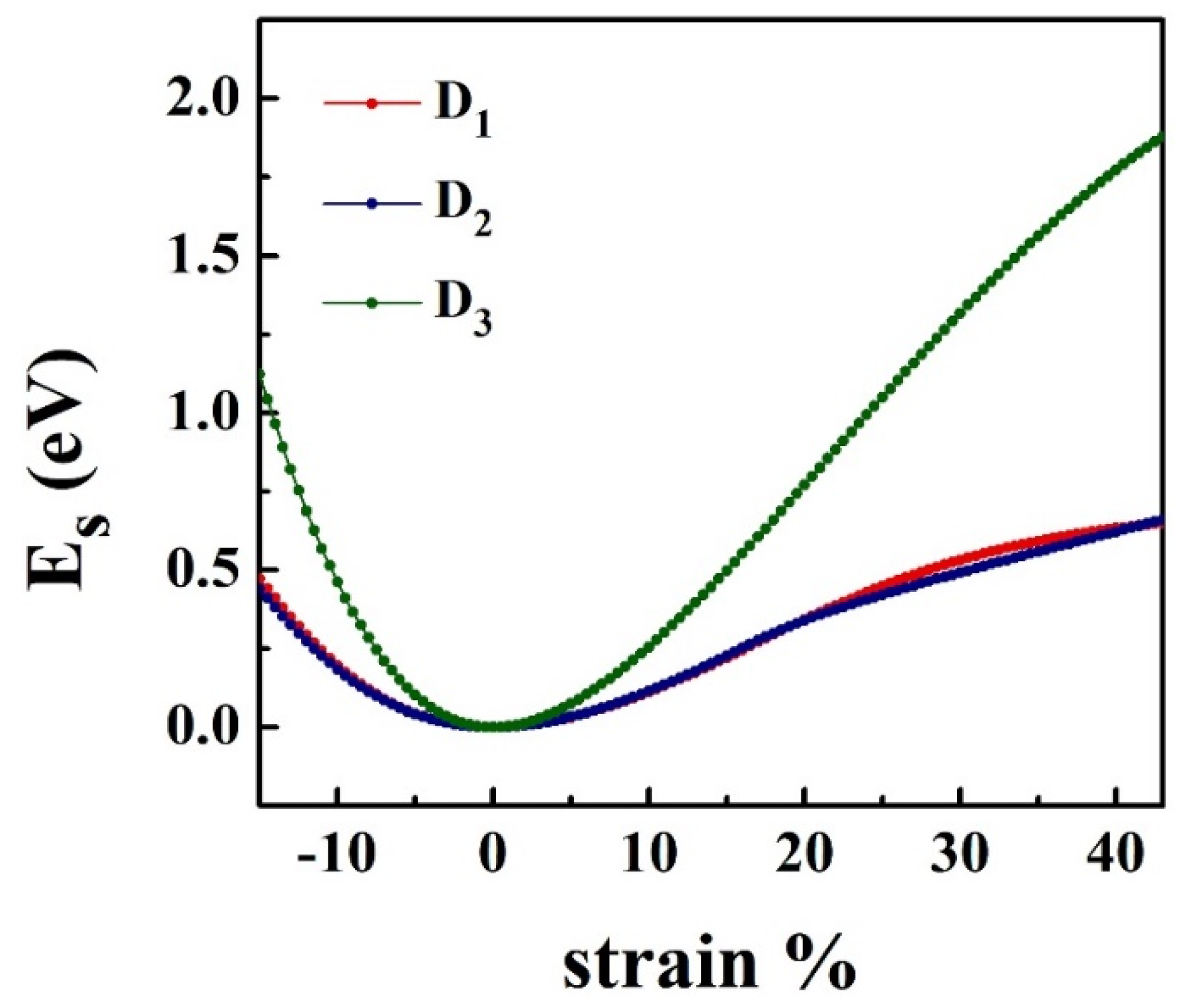
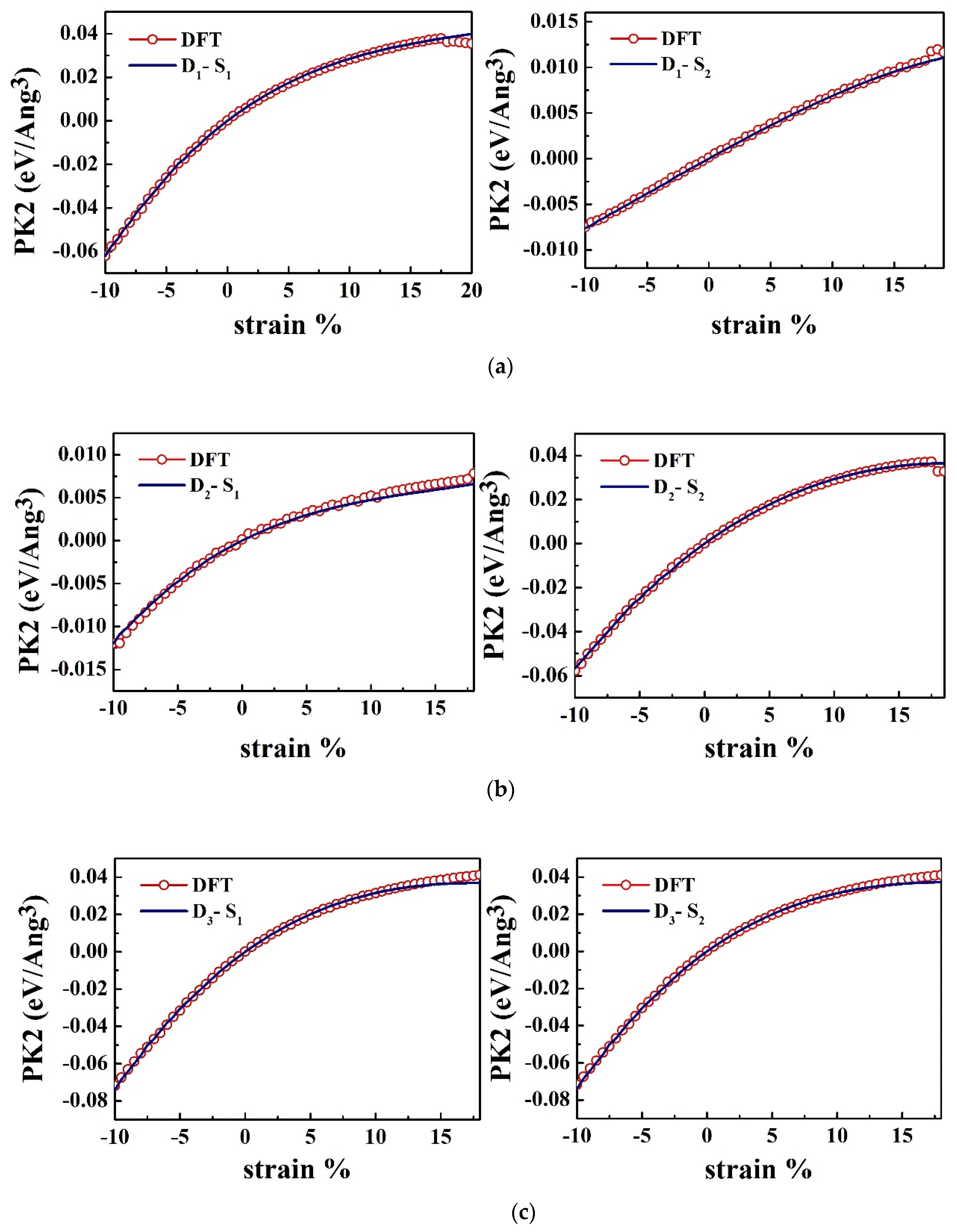


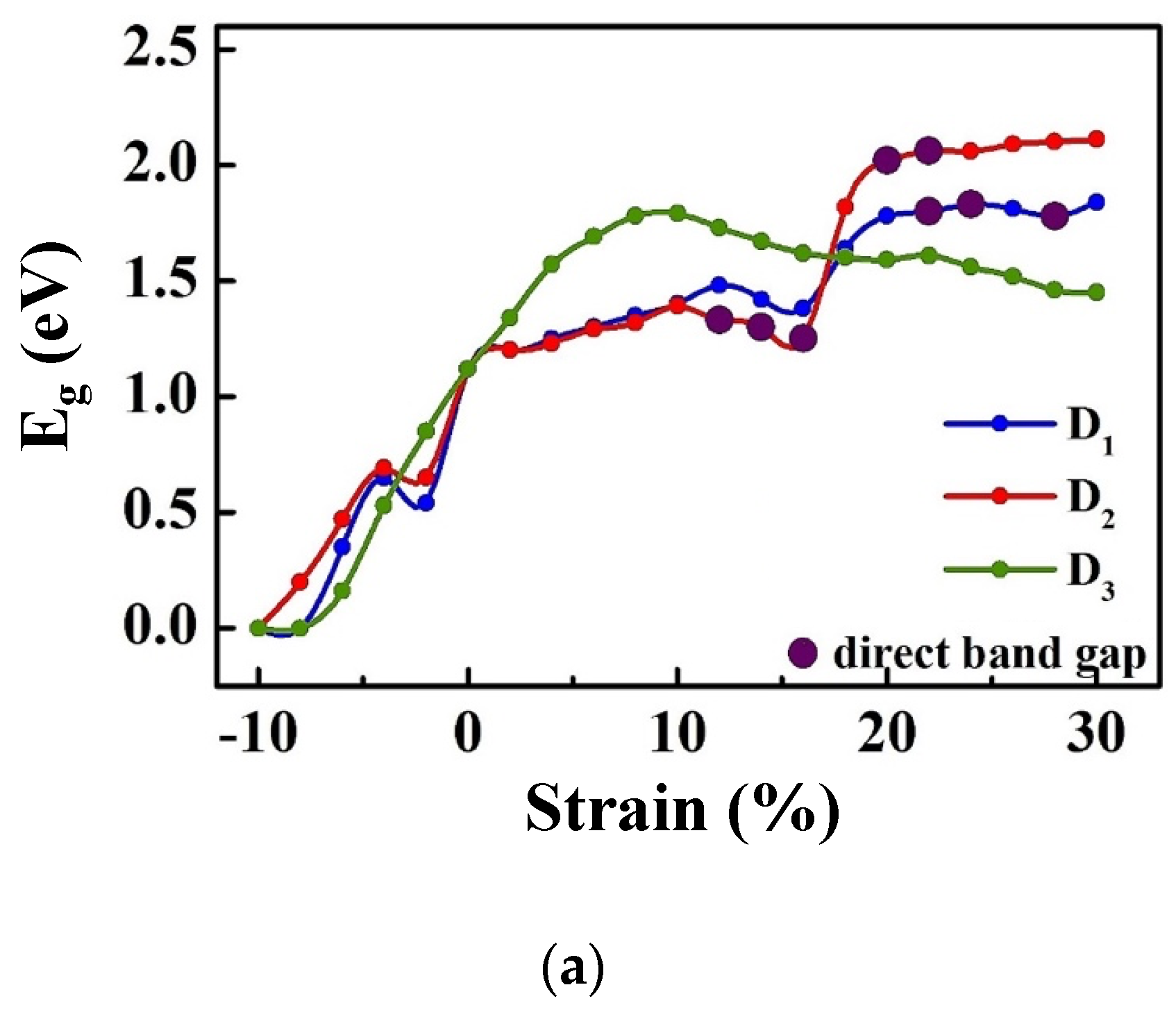
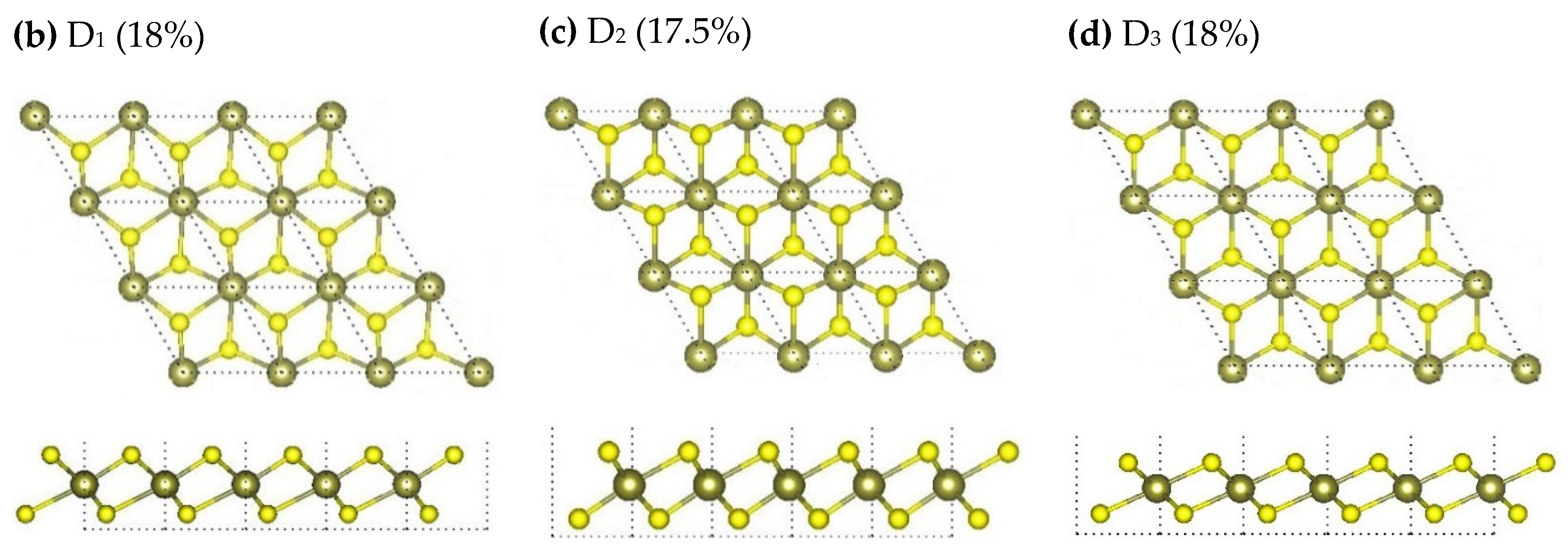
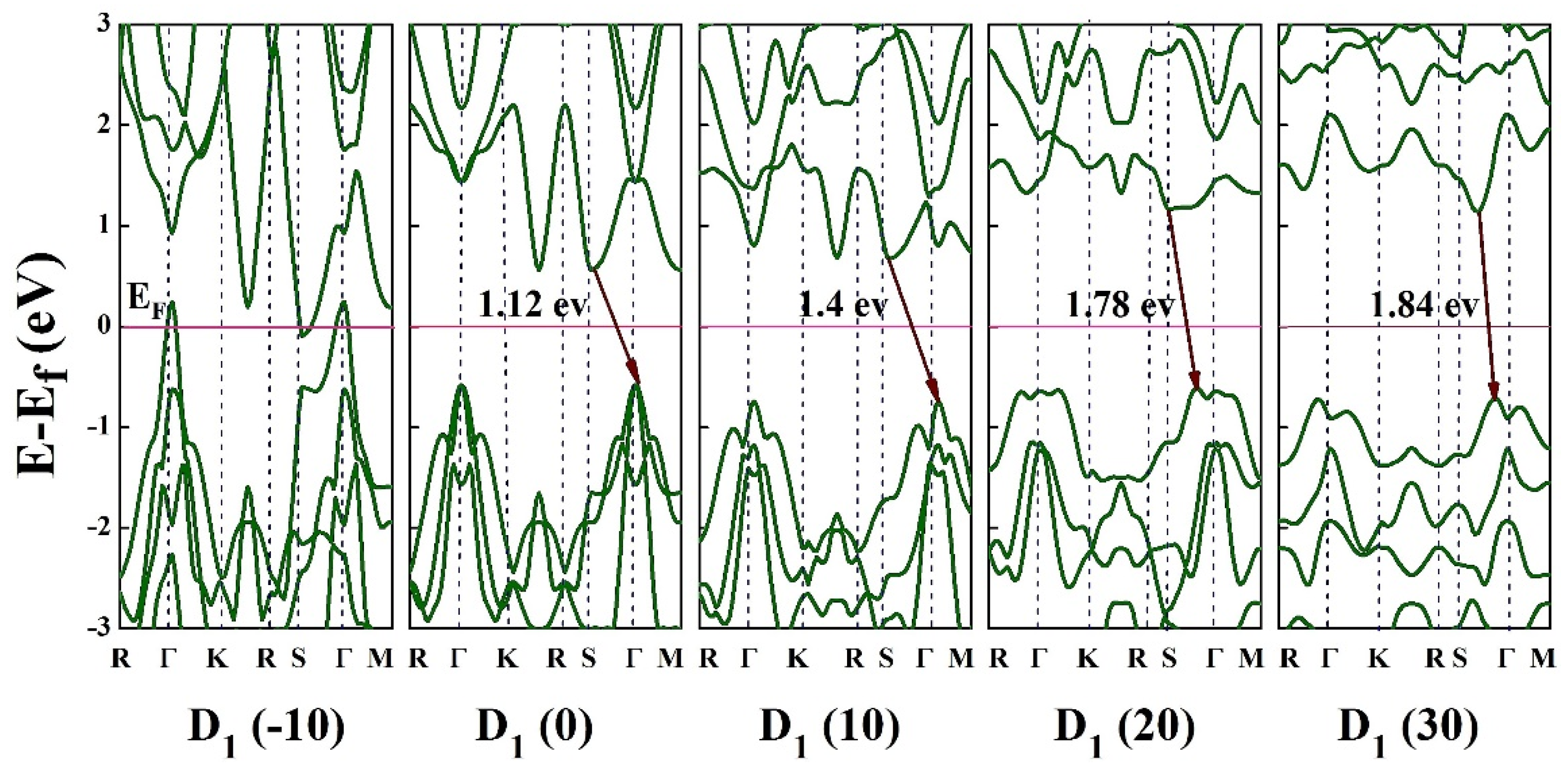

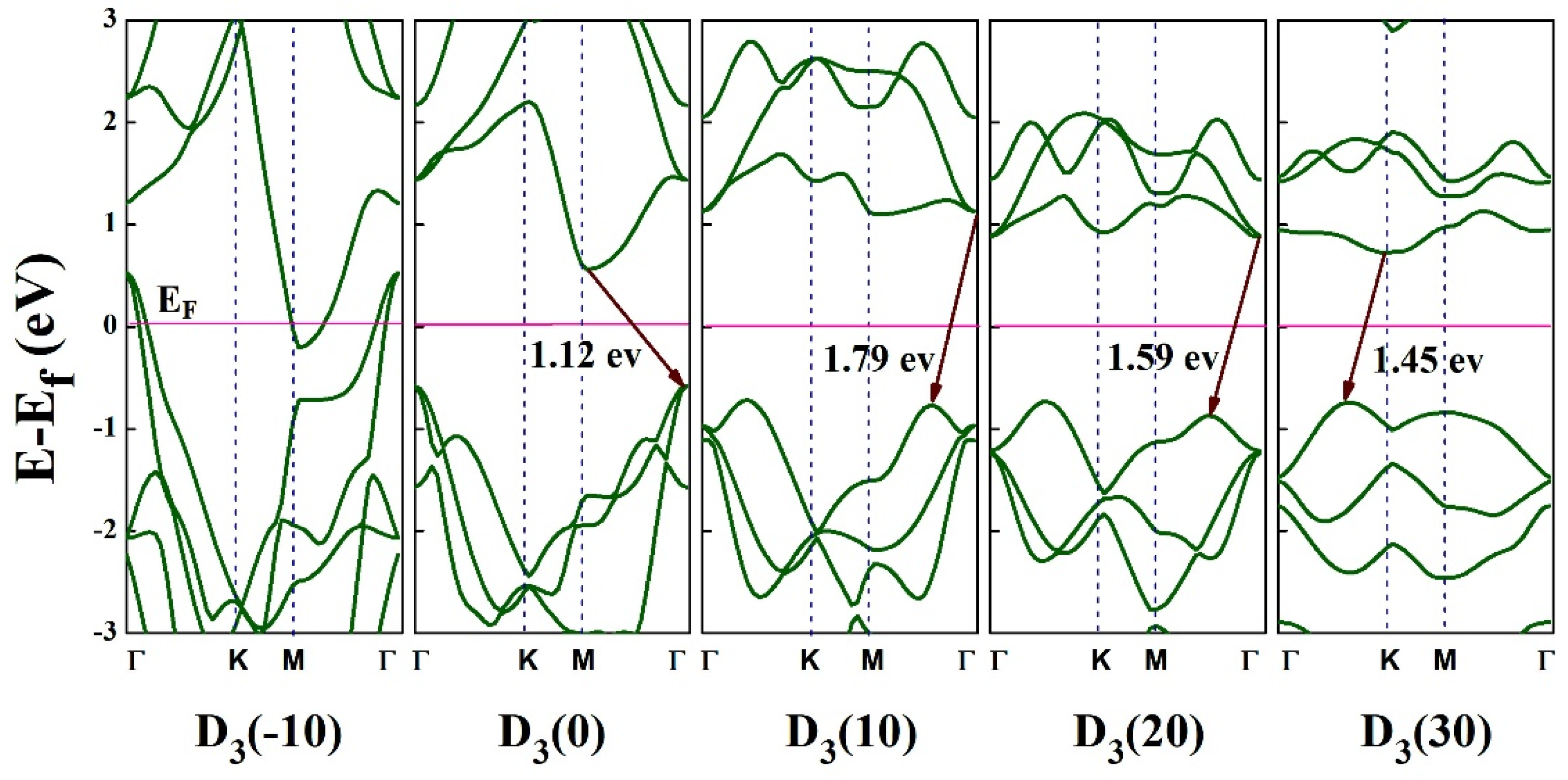
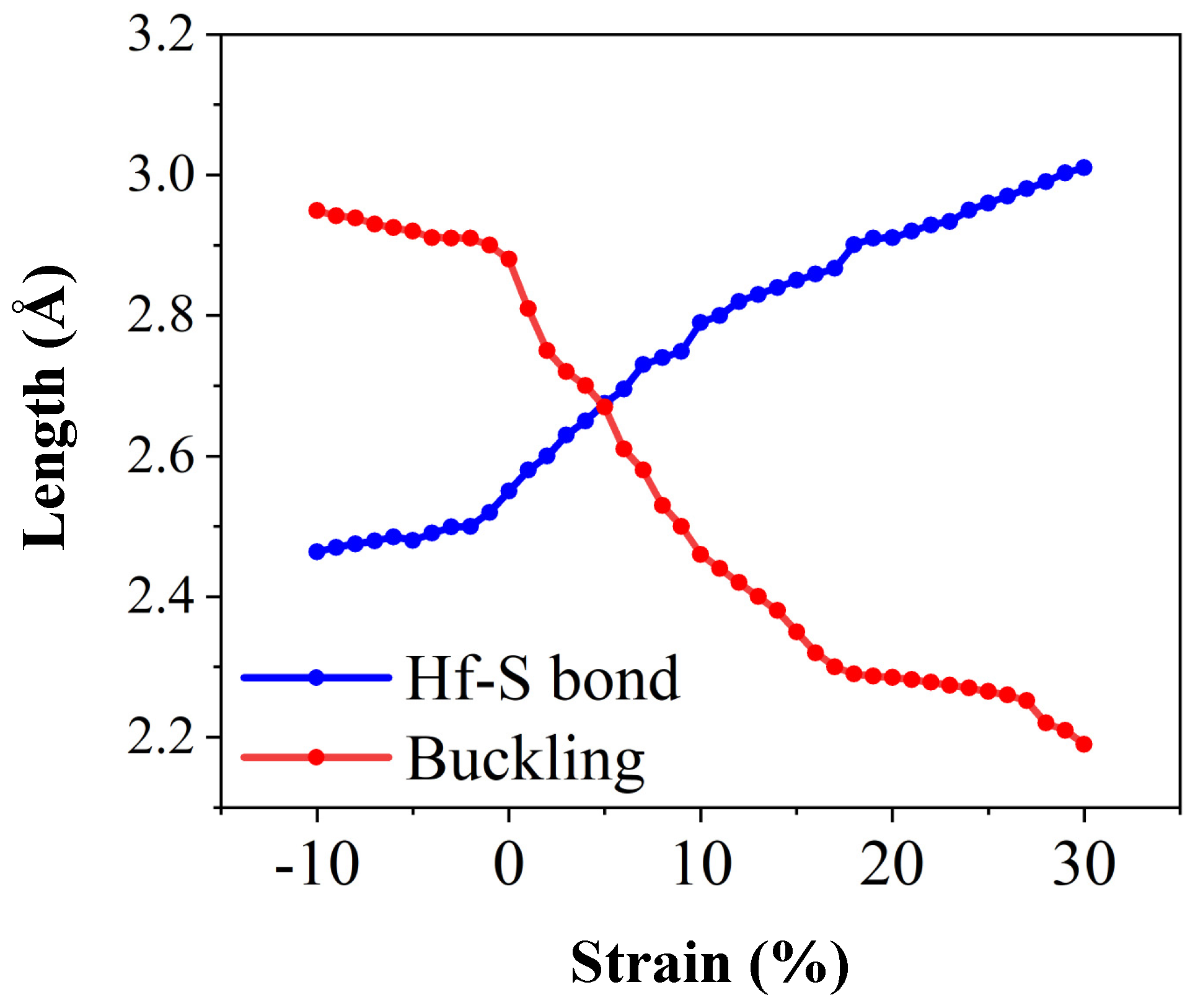
| Material | Method | Lattice Constant |
|---|---|---|
| HfS2 | PBEsol (This work) | 3.64 |
| GGA [40] | 3.54 | |
| HSE [40] | 3.53 | |
| LDA [40] | 3.38 | |
| PBE (bulk) [41] | 3.54 | |
| PBE (bulk) [38] | 3.63 | |
| vdW-TS/HI [39] | 3.61 | |
| HfSe2 | vdW-TS/HI [39] | 3.70 |
| ZrS2 | vdW-TS/HI [39] | 3.64 |
| ZrSe2 | vdW-TS/HI [39] | 3.74 |
| GaS | DFT-PBE [41] | 3.64 |
| GaSe | DFT-PBE [41] | 3.82 |
| InSe | DFT-PBE [41] | 4.09 |
| Uniaxial (x) | Uniaxial (y) | Biaxial (x-y) | |
|---|---|---|---|
| (eV/Å3) | 0.037 17.2% | 0.038 17.51% | 0.044 21.17% |
| SOEC | TOEC | FOEC | |||
|---|---|---|---|---|---|
| C11 | 86.29 | C111 | −683.81 | C1111 | 3389.08 |
| C12 | 15.28 | C112 | −14.69 | C1112 | −343.81 |
| C22 | 85.71 | C222 | −561.10 | C2222 | 1092.89 |
| C66 | 68.14 | C122 | −145.42 | C1222 | 968.49 |
| C166 | −205.85 | C6666 | −592.82 | ||
| C266 | −1118 | C1266 | 2386.80 | ||
| C1122 | −42.83 | ||||
| C2266 | −2207.16 | ||||
| C1166 | 471.75 | ||||
| Material | C11 | C12 |
|---|---|---|
| HfS2 (This work) | 86.29 | 15.28 |
| GaS [41] | 83 | 18 |
| GaSe [41] | 70 | 16 |
| InSe [41] | 51 | 12 |
| h-BN [32] | 293.2 | 66.1 |
| ZrS2 [39] | 131.47 | 25.63 |
| ZrSe2 [39] | 104.62 | 21.31 |
| HfS2 [39] | 141.98 | 25.95 |
| HfSe2 [39] | 116.88 | 22.30 |
| Material | K (N/m) | |||||
|---|---|---|---|---|---|---|
| HfS2 | 83.01 | 83.57 | 0.17 | 0.17 | 68.14 | 50.85 |
| ZrS2 [39] | 57.22 | 0.20 | 23.85 (GPa) | 31.73 (GPa) | ||
| ZrSe2 [39] | 52.33 | 0.19 | 22.02 (GPa) | 27.99 (GPa) | ||
| HfSe2 [39] | 69.59 | 0.19 | 29.34 (GPa) | 36.87 (GPa) | ||
| h-BN [32] | 279.2 | 0.2176 | - | 160 (GPa) | ||
© 2020 by the authors. Licensee MDPI, Basel, Switzerland. This article is an open access article distributed under the terms and conditions of the Creative Commons Attribution (CC BY) license (http://creativecommons.org/licenses/by/4.0/).
Share and Cite
Faghihnasiri, M.; Ahmadi, A.; Alvankar Golpayegan, S.; Garosi Sharifabadi, S.; Ramazani, A. A First-Principles Study of Nonlinear Elastic Behavior and Anisotropic Electronic Properties of Two-Dimensional HfS2. Nanomaterials 2020, 10, 446. https://doi.org/10.3390/nano10030446
Faghihnasiri M, Ahmadi A, Alvankar Golpayegan S, Garosi Sharifabadi S, Ramazani A. A First-Principles Study of Nonlinear Elastic Behavior and Anisotropic Electronic Properties of Two-Dimensional HfS2. Nanomaterials. 2020; 10(3):446. https://doi.org/10.3390/nano10030446
Chicago/Turabian StyleFaghihnasiri, Mahdi, Aidin Ahmadi, Samaneh Alvankar Golpayegan, Saeideh Garosi Sharifabadi, and Ali Ramazani. 2020. "A First-Principles Study of Nonlinear Elastic Behavior and Anisotropic Electronic Properties of Two-Dimensional HfS2" Nanomaterials 10, no. 3: 446. https://doi.org/10.3390/nano10030446
APA StyleFaghihnasiri, M., Ahmadi, A., Alvankar Golpayegan, S., Garosi Sharifabadi, S., & Ramazani, A. (2020). A First-Principles Study of Nonlinear Elastic Behavior and Anisotropic Electronic Properties of Two-Dimensional HfS2. Nanomaterials, 10(3), 446. https://doi.org/10.3390/nano10030446





